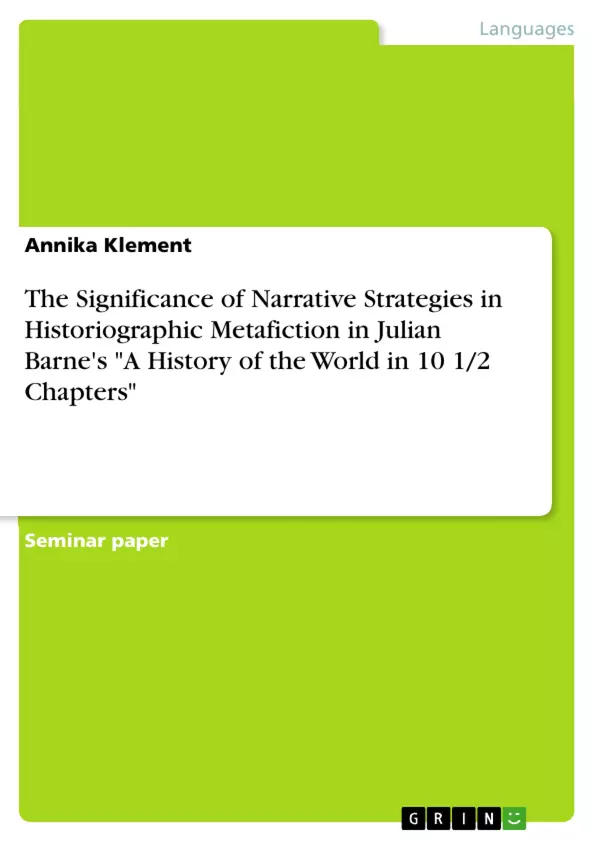In this term paper I will discuss how historiographic metafiction “reflects upon its own strategies of writing and constructing histories by drawing attention to the constructedness [and] subjectivity”. For this purpose, I will firstly elaborate the relationship of historio-graphic metafiction and narration in order to examine to which intention the narrative strategies are used by taking the example of the postmodernist novel A History of the World in 10 ½ Chapters by Julian Barnes.
Inhaltsverzeichnis (Table of Contents)
- Introduction
- Historiographic Metafiction and Narration
- Narrative Strategies in Julian Barnes' A History of the World in 10½ Chapters
- The Stowaway
- The Survivor
Zielsetzung und Themenschwerpunkte (Objectives and Key Themes)
This term paper examines the concept of “Historiographic Metafiction” and its perception of truth within the context of postmodern historiography. It explores the relationship between historiographic metafiction and narration, focusing on how narrative strategies are employed to convey subjectivity and constructedness in historical discourse. The paper will use Julian Barnes' novel, A History of the World in 10½ Chapters, as a case study.
- Historiographic Metafiction and its relation to narration
- The role of narrative techniques in conveying subjectivity and constructedness
- The use of parody and self-reflexivity in historiographic metafiction
- The portrayal of history from the perspectives of victims and minorities
- The questioning of universal truth and the subjectivity of historical accounts
Zusammenfassung der Kapitel (Chapter Summaries)
The introduction provides a theoretical framework for understanding Historiographic Metafiction, focusing on its self-awareness of history and fiction as human constructs. It highlights the key themes of intertextuality, parody, self-reflexivity, and self-consciousness. The chapter concludes with a brief overview of the novel, A History of the World in 10 ½ Chapters, by Julian Barnes, which will be used as a case study for analyzing these concepts.
The first chapter, "The Stowaway," presents a revisionist account of the Deluge from the perspective of a woodworm, a marginalized creature deemed unclean. This narrative strategy highlights the subjective and constructed nature of historical accounts, particularly when viewed from the perspective of those outside the mainstream narrative. The woodworm narrator challenges the authority of the biblical account by introducing alternative versions of events, thereby questioning the notion of a singular and objective truth.
Schlüsselwörter (Keywords)
The key terms and concepts explored in this work include historiographic metafiction, narration, subjectivity, constructedness, intertextuality, parody, self-reflexivity, self-consciousness, victims, minorities, and the questioning of universal truth. These themes are further examined through the analysis of Julian Barnes' novel, A History of the World in 10½ Chapters.
- Quote paper
- Annika Klement (Author), 2018, The Significance of Narrative Strategies in Historiographic Metafiction in Julian Barne's "A History of the World in 10 1/2 Chapters", Munich, GRIN Verlag, https://www.grin.com/document/440899



